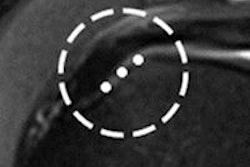MR arthrography outperformed 3-tesla MRI in diagnosing partial-thickness supraspinatus tendon tears and superior labrum from anterior to posterior (SLAP) tears in a recent study.
MR arthrography also was more accurate than conventional MR in diagnosing full-thickness supraspinatus tendon tears, as well as anterior and posterior labral tears, but the statistical difference was less significant.
Research results were released at the recent 2008 RSNA meeting in Chicago.
"The purpose of the study was to assess how often we need MR arthroscopy with 3-tesla MR imaging," said study co-author Dr. Thomas Magee of the Neuroskeletal Imaging Institute in Merritt Island, FL.
Study criteria
The institute evaluated 150 consecutive conventional shoulder MR and MR arthrography examinations performed on patients 50 years of age or younger, who also went on to receive arthrograms. The exams were reviewed retrospectively by consensus reading with two musculoskeletal radiologists. Full- or partial-thickness supraspinatus tendon tears, SLAP tears, and anterior or posterior labral tears were assessed.
All patients consented to having both conventional MR and MR arthrograms performed, and the researchers excluded patients who had prior shoulder surgery.
The 3-tesla MR exams included T2-weighted fat-saturated coronal sagittal images, proton density fat-saturated axial images, and coronal T1-weighted images. All MR arthrograms were performed immediately after the conventional MR examinations. MR arthrography patients had T1-weighted fat-saturated imaging in all three planes.
Random readings
The images were read in a randomized fashion to avoid introducing bias into the readers' reviews.
In the exams, researchers found 41 anterior labral tears, 19 posterior labral tears, 47 SLAP tears, and 36 full-thickness and 51 partial-thickness supraspinatus tendon tears seen through arthroscopy. On conventional 3-tesla MR, 34 anterior labral tears, 16 posterior labral tears, 39 SLAP tears, and 33 full-thickness and 38 partial-thickness supraspinatus tendon tears were observed. On MR arthrography, 40 anterior labral tears, 18 posterior labral tears, 46 SLAP tears, and 36 full-thickness and 47 partial-thickness supraspinatus tendon tears were recorded.
Three-tesla MR showed adequate sensitivity, while MR arthrography demonstrated "statistically significant differences in sensitivity for detection of partial-thickness articular surface, supraspinatus tendon tears, anterior labral tears, and SLAP tears at 3-tesla [MRI]," Magee said.
|
|||||||||||||||||||||||
In addition, there were 27 additional findings with MR arthrography compared to conventional MR examination in the study.
"We found three additional full-thickness supraspinatus tendon tears, nine partial-thickness supraspinatus tendon tears along the articular surface, seven SLAP tears, six anterior labral tears, and two posterior labral tears seen on MR arthrography, but not well seen on conventional MR examination," Magee noted. "All the additional MR arthrography findings were seen on arthroscopy."
Based on those findings, the center was able to perform MR arthrography on patients in which anterior labral tears, SLAP tears, and partial-thickness supraspinatus tendon tears were suspected clinically.
By Wayne Forrest
AuntMinnie.com staff writer
December 12, 2008
Related Reading
MR arthrography study finds 'optimal injection site,' October 24, 2008
Making the most of MRI to assess the rotator cuff pre- and postinjury, November 9, 2007
MRI keeps pace with rapidly evolving musculoskeletal systems of young athletes, May 20, 2007
MR arthrography depicts tears, instability in triangular fibrocartilage complex, January 19, 2007
MR arthrography typifies cam and pincer FAI for intracapsular hip surgery, August 22, 2006
Copyright © 2008 AuntMinnie.com



.fFmgij6Hin.png?auto=compress%2Cformat&fit=crop&h=100&q=70&w=100)




.fFmgij6Hin.png?auto=compress%2Cformat&fit=crop&h=167&q=70&w=250)











